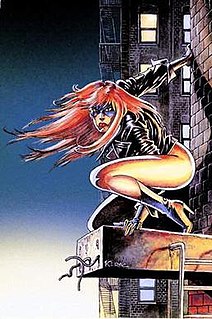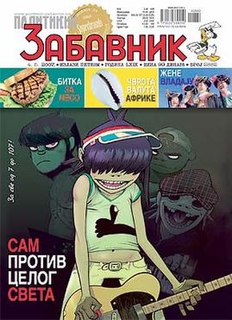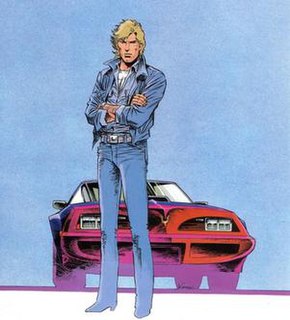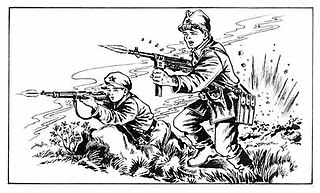
Cat Claw is a fictional comic book superhero created by Serbian artist Branislav Kerac and writer Svetozar Obradović.
The Steel Claw was one of the most popular comic book heroes of British weekly adventure comics of the 1960s and 1970s. The character was revived in 2005 for Albion, a six issue mini-series published by the Wildstorm imprint of DC Comics.
Zoran Janjetov is a Serbian comics artist. Janjetov is among most prominent comics creators of former Yugoslavia, published worldwide. He is best known as the illustrator of Avant l'Incal and The Technopriests, written by Alejandro Jodorowsky.

Politikin Zabavnik is a popular magazine in Serbia, published by Politika Newspapers and Magazines.
Nantier Beall Minoustchine Publishing Inc. is an American graphic novel publisher. Founded by Terry Nantier in 1976 as Flying Buttress Publications, NBM is one of the oldest graphic novel publishers in North America. The company publishes English adaptations and translations of popular European comics, compilations of classic comic strips, and original fiction and nonfiction graphic novels. In addition to NBM Graphic Novels, the company has several imprints including Papercutz with comics geared towards younger audiences, ComicsLit for literary graphic fiction, and Eurotica and Amerotica for adult comics.

Kobra was a Yugoslav comic book created by artist Branislav Kerac and writer Svetozar Obradović. The main character of the comic is a young stunt man, nicknamed Kobra.
Serbian comics are comics produced in Serbia. Comics are called stripovi in Serbian and come in all shapes and sizes, merging influences from American comics to bandes dessinées.

Ritam was a Serbian and Yugoslav popular culture magazine.
Albanian comics, though not well known internationally, were produced mainly by comic-authors from Kosovo. Until recently there was no comic tradition in Albania where comics were seen as junk literature known as fumeti supposedly because pop art was prohibited by the dictatorial communist regime. Today there is one comic magazine published in Kosovo called Leon, and there is Tafë Kusuri comic-strip together with Garfield and Calvin and Hobbes published by Koha Ditore newspaper.

Dobrica Erić was a Serbian writer and poet.

Džuboks was a Yugoslav music magazine. Launched in 1966, it was the very first magazine in SFR Yugoslavia dedicated predominantly to rock music and the first rock music magazine to be published in a communist country.
Vujadin "Vuja" Radovanović is a Serbian comic-book and graphic novel creator.
Đorđe Lobačev or Yuriy Lobachev was a Soviet Russian and Serbian-Yugoslavian comic strip author and illustrator. He was one of the pioneers of the comic strip in the Kingdom of Yugoslavia in the interwar period. Most of his comics from this period have themes from the history of Serbia and Serbian folklore. He lived Yugoslavia until 1949 when he was expelled during the Informbiro period because he was a Soviet citizen. He lived in Romania for few years before moving to the Soviet Russia where he spent the rest of his life. He was the author of the first Soviet comic strip Hurricane Comes to the Rescue in 1966.

Mirko and Slavko was a Yugoslav comic book series about two Partisan couriers, started in 1958 and ended in 1979. The creator and the main author of the series was artist Desimir Žižović "Buin". During the 1960s and early 1970s, Mirko and Slavko was the most popular comic in Yugoslavia, becoming the only Yugoslav comic to be adapted into a live action film during the existence of the country.

Željko Pahek is an internationally published comic-book and graphic novel creator, scriptwriter, painter, illustrator and caricaturist.

Ninja was a Yugoslav comic strip published by Dečje novine. Created in 1986, it was based on the series of pulp novels of the same name written by Yugoslav writer Brana Nikolić.

Sibin Slavković is a Serbian comic book artist, illustrator and editor.
Branko Plavšić was a Serbian comic book artist, best known for his work on Tarzan and Blek.
Nikola Maslovara Masli (Serbian Cyrillic: Никола Масловара Масли, Odžaci, 22 December 1946 ) is a Serbian comics creator, cartoonist, caricaturist, scriptwriter, animator, editor, publisher and art teacher.
Yugoslav science fiction comprises literary works, films, comic books and other works of art in the science fiction genre created in Yugoslavia during its existence (1918–1991).









